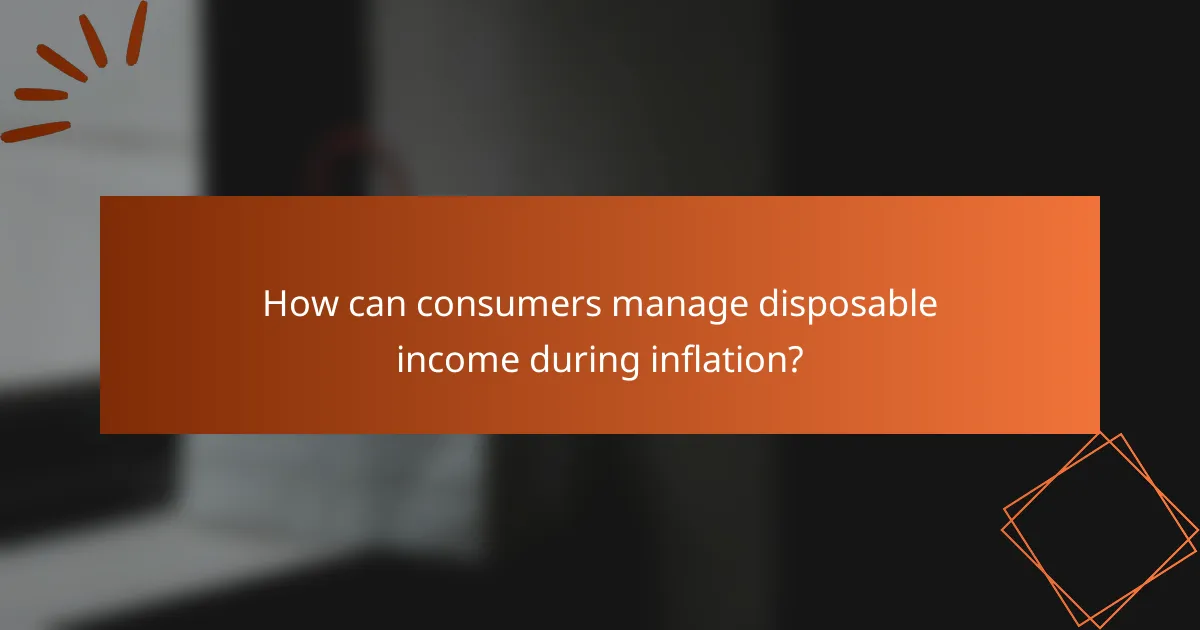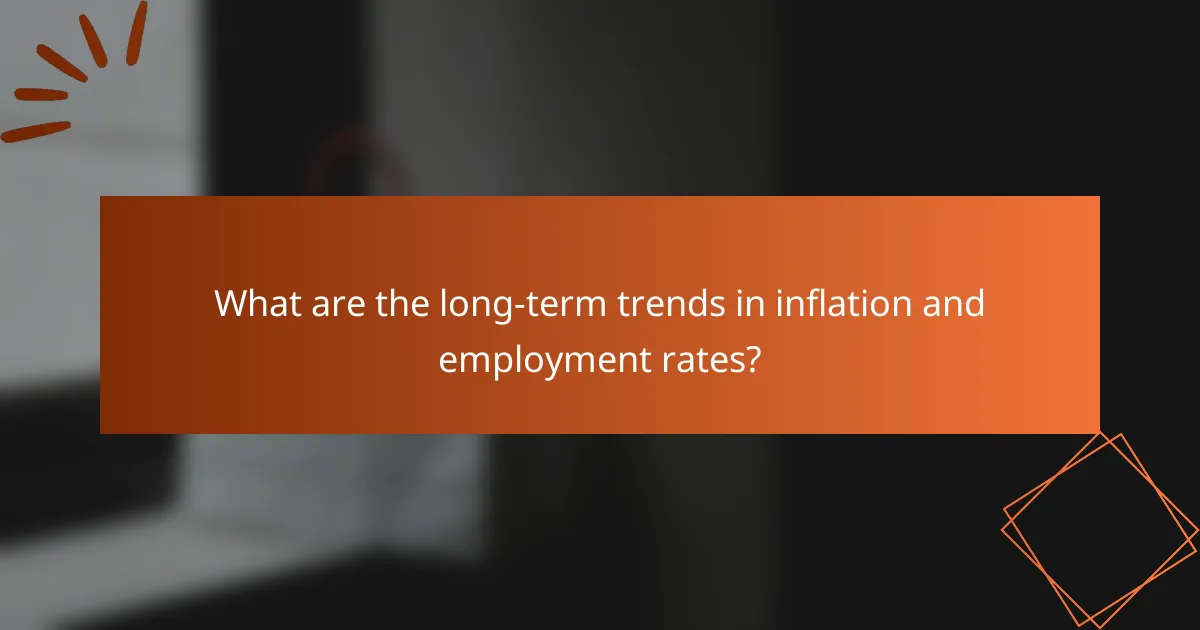Economic factors such as inflation, employment rates, and disposable income are intricately linked, influencing consumer behavior and overall financial health. Rising inflation diminishes disposable income by increasing the cost of living, while varying employment rates across major cities affect wage levels and job availability. Understanding these dynamics is crucial for analyzing how households manage their budgets and spending in an ever-changing economic landscape.

How does inflation impact disposable income in the US?
Inflation reduces disposable income in the US by increasing prices for goods and services, which means consumers can buy less with the same amount of money. As inflation rises, households often find their earnings do not stretch as far, leading to tighter budgets and altered spending habits.
Reduction in purchasing power
Inflation directly leads to a reduction in purchasing power, meaning that each dollar buys fewer goods and services than before. For example, if inflation is around 3%, a product that costs $100 today may cost $103 next year, effectively diminishing the value of money held by consumers.
This reduction in purchasing power can force consumers to prioritize essential purchases over discretionary spending, impacting overall economic activity. Households may need to adjust their budgets to accommodate these changes, often leading to a decrease in overall consumption.
Increased cost of living
As inflation rises, the cost of living typically increases, affecting housing, food, healthcare, and transportation expenses. For instance, if rent prices increase due to inflation, families may find themselves allocating a larger portion of their income to housing, leaving less for savings or leisure activities.
To manage the increased cost of living, individuals may seek additional income sources, such as part-time jobs or side gigs. However, this can lead to increased stress and reduced quality of life as people work longer hours to maintain their standard of living.
Effect on savings rates
Inflation can negatively impact savings rates, as rising prices may encourage consumers to spend rather than save. When inflation outpaces interest rates on savings accounts, the real value of savings diminishes, discouraging individuals from setting aside money for future needs.
To counteract this, consumers might consider investing in assets that typically outpace inflation, such as stocks or real estate. However, these options come with their own risks and may not be suitable for everyone, particularly those with lower disposable incomes.

What are the current employment rates in major US cities?
The employment rates in major US cities vary significantly, reflecting local economic conditions. As of now, cities like New York, Los Angeles, and Chicago show different unemployment trends influenced by various factors such as industry presence and economic policies.
Unemployment rate in New York City
New York City’s unemployment rate is typically lower than the national average, often hovering around the low single digits. The city’s diverse economy, which includes finance, technology, and tourism, contributes to its robust job market.
However, fluctuations can occur due to seasonal employment changes, particularly in the hospitality sector. It’s advisable for job seekers to consider networking and leveraging local job fairs to enhance their chances of employment.
Unemployment rate in Los Angeles
Los Angeles generally experiences a higher unemployment rate compared to New York, often in the mid-single digits. The entertainment industry plays a significant role in the local economy, but it can be volatile, affecting job stability.
Job seekers in Los Angeles should focus on industries that are growing, such as technology and healthcare, as these sectors are more resilient. Utilizing online job platforms and local recruitment agencies can also be beneficial.
Unemployment rate in Chicago
Chicago’s unemployment rate is usually in the mid to high single digits, influenced by its manufacturing and service sectors. Economic shifts and policies can impact job availability, making it essential for residents to stay informed about local economic trends.
For those looking for work, targeting sectors like logistics and healthcare can provide better opportunities. Engaging with community resources and job training programs can also enhance employability in this competitive market.

How do employment rates influence disposable income?
Employment rates significantly impact disposable income by determining the number of individuals earning wages. Higher employment typically leads to increased income levels, which directly enhances the amount of money available for spending after taxes and essential expenses.
Higher employment leads to increased income
When employment rates rise, more individuals have jobs, resulting in greater overall income in the economy. This increase in income can lead to higher disposable income as workers receive wages that can be spent on goods and services. For example, in a thriving job market, average salaries may rise, allowing families to allocate more funds for discretionary spending.
Moreover, as more people gain employment, businesses often experience increased demand for their products, which can lead to further hiring and wage growth. This cycle reinforces the relationship between employment rates and disposable income, creating a positive feedback loop that benefits the economy.
Job security affects consumer spending
Job security plays a crucial role in influencing consumer spending patterns. When individuals feel secure in their jobs, they are more likely to spend their disposable income on non-essential items, contributing to economic growth. Conversely, uncertainty about job stability can lead to cautious spending, as consumers prioritize saving over discretionary purchases.
For instance, during economic downturns or periods of high unemployment, consumers may reduce spending significantly, opting to save for potential emergencies. This behavior can slow economic recovery, highlighting the importance of job security in maintaining robust consumer confidence and spending levels.

What are the effects of inflation on consumer behavior?
Inflation significantly impacts consumer behavior by altering purchasing power and spending habits. As prices rise, consumers tend to prioritize essential items over non-essential goods, leading to shifts in market demand.
Shift towards essential goods
During periods of inflation, consumers often redirect their spending towards essential goods such as food, healthcare, and housing. This shift occurs because individuals prioritize necessities to maintain their quality of life, often at the expense of luxury items or services.
For example, a family may choose to buy generic brands or shop at discount stores to stretch their budgets further. This trend can lead to increased sales for essential goods retailers while luxury brands may experience a decline in demand.
Decrease in discretionary spending
Inflation typically results in a decrease in discretionary spending as consumers become more cautious with their finances. As prices rise, households may cut back on non-essential purchases like dining out, entertainment, and vacations.
For instance, a consumer might opt for a staycation instead of an international trip, or reduce the frequency of dining at restaurants. This behavior can lead to slower growth for sectors reliant on discretionary spending, such as hospitality and leisure industries.

How can consumers manage disposable income during inflation?
Consumers can manage disposable income during inflation by adjusting their spending habits and prioritizing essential expenses. This involves creating a budget, identifying areas to cut costs, and exploring investment options that can help preserve purchasing power.
Budgeting strategies
Effective budgeting is crucial for managing disposable income in an inflationary environment. Start by tracking all income and expenses to understand where money is going. Allocate funds to essential categories such as housing, food, and transportation while minimizing discretionary spending.
Consider using the 50/30/20 rule, where 50% of income goes to needs, 30% to wants, and 20% to savings or debt repayment. Adjust these percentages based on personal circumstances, especially during inflation when prices rise.
Investment in inflation-protected assets
Investing in inflation-protected assets can help maintain the value of disposable income. Options include Treasury Inflation-Protected Securities (TIPS), which adjust with inflation, or commodities like gold that often retain value during economic downturns.
Real estate can also serve as a hedge against inflation, as property values and rents typically rise over time. Diversifying investments across various inflation-resistant assets can provide a buffer against rising costs and help secure financial stability.

What are the long-term trends in inflation and employment rates?
Long-term trends in inflation and employment rates indicate a complex relationship where rising inflation often correlates with fluctuating employment levels. Understanding these trends helps in predicting economic stability and consumer behavior.
Historical inflation trends in the US
Historically, inflation in the US has experienced significant fluctuations, with notable spikes during the 1970s and early 1980s, often exceeding 10%. More recently, inflation rates have generally remained lower, typically in the range of 1% to 3% annually, until a surge in 2021 and 2022 due to pandemic-related factors.
Key influences on inflation include monetary policy, supply chain disruptions, and consumer demand. The Federal Reserve plays a crucial role in managing inflation through interest rate adjustments, aiming to maintain price stability while supporting employment.
Future employment projections
Future employment projections suggest a gradual recovery and growth in various sectors, particularly technology, healthcare, and renewable energy. The US Bureau of Labor Statistics anticipates job growth rates of around 5% to 10% over the next decade, depending on the industry.
Factors influencing employment trends include demographic shifts, technological advancements, and economic policies. Businesses and job seekers should stay informed about these trends to adapt to changing job markets and opportunities effectively.

What emerging economic factors should consumers watch?
Consumers should pay attention to inflation, employment rates, and disposable income as these factors significantly influence purchasing power and overall economic stability. Understanding these elements can help consumers make informed financial decisions and anticipate market trends.
Impact of technology on job markets
Technology is reshaping job markets by automating tasks and creating new job categories. While automation can lead to job displacement in certain sectors, it also generates opportunities in tech-driven fields such as data analysis and cybersecurity.
Consumers should consider the skills required for emerging roles and invest in continuous learning to stay competitive. Upskilling can enhance employability and potentially lead to higher disposable income in the long run.
Global supply chain disruptions
Global supply chain disruptions, often caused by geopolitical tensions or natural disasters, can lead to shortages and increased prices for goods. Consumers may notice rising costs in everyday items, affecting their disposable income and spending habits.
To mitigate the impact of these disruptions, consumers can diversify their purchasing sources and consider local alternatives. Being flexible with brands and products can help maintain budget stability during times of uncertainty.

